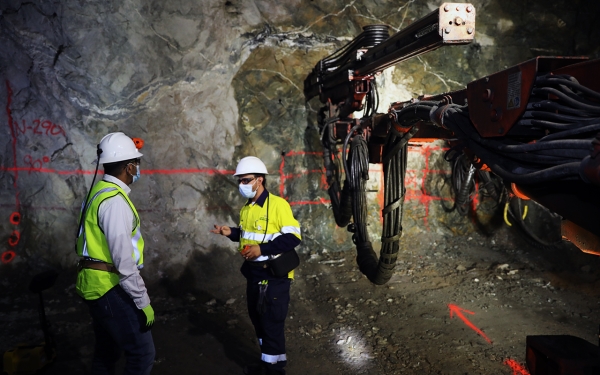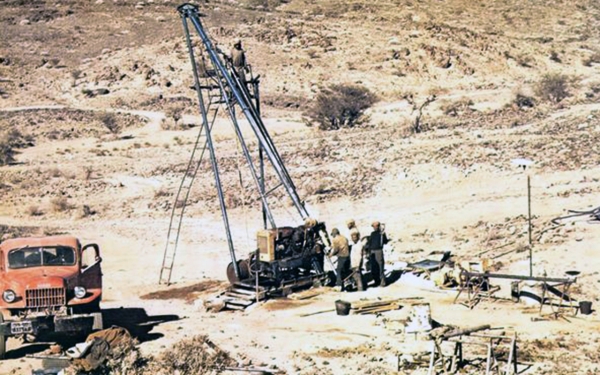




Mining in Saudi Arabia is one of the most prominent economic sectors in the Kingdom of Saudi Arabia and the third pillar of its national economy. The Kingdom ranks thirteenth globally in terms of the abundance and diversity of minerals and mineral resources that exceed forty-eight types, and includes about fifteen minerals that can be exploited economically.
The Kingdom has the largest reserves of phosphate and tantalum in the world. It is also the largest country in the Middle East to own gold reserves, reaching 323.1 tons in 2022, while producing 435 thousand ounces in 2020. The central and northern regions store large quantities of bauxite, silver, zinc, copper, magnesium and kaolin.
The emergence of mining in Saudi Arabia
The journey of mining in the Kingdom began in the 1930s. The initial exploration and mining activities occurred in 1931 when the Founding King, Abdulaziz Bin Abdulrahman Al Saud, directed the American geologist Karl Twitchell to search for water and minerals in the Kingdom. As a result, the Saudi Arabian Mining Syndicate was established in 1934 and started mining in the well-known mines at that time, notably the Mahd al-Dhahab Gold Mine.
In 1954, the Saudi government established the Directorate of Oil and Mineral Affairs under the Ministry of Finance to oversee the mineral sector and mining agreements in the Kingdom. In 1960, the Ministry of Petroleum and Mineral Resources was formed to oversee the petroleum and mineral sectors, which included the Directorate of Oil and Mineral Affairs. Back in 1962, the General Directorate of Mineral Resources was founded with the intention of laying a strong groundwork for the Kingdom's national geological and mineral infrastructure.
The Kingdom's first mining law was issued in 1963, which includes the Ministry of Petroleum and Mineral Resources conducting exploration operations by itself or through consulting companies. In 1997, the Saudi Arabian Mining Company "Ma'aden" was established by a Royal Decree to practice various aspects of mining activity in the Kingdom.
Mineral exploration in the Kingdom
The Kingdom has implemented various measures to investigate its mineral resources. These include offering digital information related to earth sciences, maps, and technical details. It has also increased preliminary exploration and aerial surveys, created exploration incubators to support small and medium-sized companies in contributing to exploration operations, and launched detailed exploration operations, primarily involving local and international private sectors. To accelerate the exploration of mineral ores, a program has been developed to encourage experienced companies, attract global expertise, and train Saudi nationals. Additionally, efforts are being made to develop the mining investment law and expedite the issuance of licenses.
The role of mining in the economic growth in the Kingdom
The Ministry of Industry and Mineral Resources reported that the Kingdom earned around SAR4.9 billion from mining, as stated in the Saudi Central Bank's fifty-seventh annual report for 2021. The Kingdom's reserve of natural mineral resources is estimated at more than 5,300 sites, with an estimated SAR5 trillion.
The Kingdom aims to increase the contribution of the mining industry to the Kingdom's gross domestic product (GDP) to SAR240 billion and raise the Kingdom's revenues from the sector by more than SAR8.9 billion.
Based on the total amount of existing factories at approximately 1,984, factories engaged in non-metallic mineral products constitute the largest industrial activities in the Kingdom. This sector's direct and indirect jobs are estimated at about 150,000, most of which fall into the intermediate and downstream industries.
Mining activities in the Kingdom
The number of approved mining complexes and mining reserve sites reached 428 locations, covering an area exceeding 69,000 km2, according to the preliminary estimates of the Ministry of Industry and Mineral Resources for the year 2020. These sites are distributed across all regions of the Kingdom, including twenty-four mining complexes in the Eastern Region, four mining complexes in the Northern Borders region, and four mineral reserve sites.
Tabuk Province has fourteen mining sites and four reserve sites, while al-Qassim Province has one reserve site and twenty-one mining sites. Makkah al-Mukarramah Province boasts seventy-two mining sites and nine reserve sites, and Riyadh Province has fifty-three sites for various mining activities and twenty-two reserve sites.
Al-Bahah Province has seventeen mining sites, while al-Madinah al-Munawwarah Province has fifty-two mining sites along with eight reserve sites. Similarly, Jazan has eleven mining sites, al-Jawf Province has eighteen mining sites and four reserve sites, and Najran Province has twenty-four sites for mining complexes along with four reserve sites.
In Aseer Province, there are thirty-two mining sites and eleven reserve sites. Hail Province, on the other hand, has three reserve sites and sixteen mining sites.
The mining investment law categorizes ores and minerals into three categories: Category (A), which includes metallic minerals, precious stones, semi-precious stones, and ores that require processing. Category (B) includes non-metallic minerals, industrial minerals, and raw materials used in manufacturing limestone, kaolin, and feldspar. Category (C) includes abundant materials found in nature and used as raw materials for construction purposes.
The size of mineral production in the Kingdom
According to the estimates of the Ministry of Industry and Mineral Resources for the year 2020, gold production reached 13,222 kg, silver production reached about 7,479 kg, and the Kingdom's production of copper concentrates increased during the same year to 92,915 t. Zinc production was 54,448 t.
Regarding other mineral ores, the total quantities extracted in 2020 were over 514,756 t of various mineral ores. These include limestone, silica sand, salt, clay, feldspar, industrial marble, iron sand, kaolin, gypsum, marble blocks, granite, limestone, phosphate, bauxite, as well as crusher materials and ordinary sand used in construction and building works.
Authorities responsible for mining and minerals
The Deputy Ministry of Mineral Resources, under the Ministry of Industry and Mineral Resources, oversees mining activities in the Kingdom. It encourages investment in the mining sector and provides services and consultations to support this activity. The deputy ministry also issues mining licenses and permits under applicable regulations and laws.
The Saudi Geological Survey (SGS) plays a role in conducting surveys, exploration, and prospecting for minerals and industrial rocks. It is responsible for preparing maps and reports and conducting geological and hydrological studies. SGS works to create investment opportunities in the mining industry and natural resources sector, aiming to stimulate economic growth and provide job opportunities.
Ma'aden, the Saudi Arabian Mining Company, is dedicated to developing the Kingdom's mineral resources with a primary focus on gold mining. Currently, it operates six gold mines, which include Mahd al-Dhahab, al-Hajar, Sukhaybarat, Bilghah, al-Amar, and al-Suq.
Ma'aden is expanding its activities outside the scope of the gold business, as it is developing phosphate and aluminum projects, as well as copper concentration operations. The company also cooperated with the government and local legislators to develop a regulatory framework to regulate and manage the mining industry in Saudi Arabia.
Mining licenses in the Kingdom
By the end of 2020, the total number of mining licenses reached around 2,062. These licenses include sixty-nine for small-scale mines that cover various industrial minerals such as silica sand, gypsum, salt, limestone, clay, basalt, Pozzolan pumice, industrial marble, low-grade iron for the cement industry, dolomite, feldspar, barite, sandstone, perlite, and pyrophyllite.
The number of mining licenses reached thirty-three licenses, while seventy licenses were issued for raw material quarries. These licenses cover various metallic minerals such as gold, copper, zinc, iron, phosphates, associated minerals, and gemstones like peridot.
Government initiatives to develop the Saudi mining sector
The Ministry of Industry and Mineral Resources has implemented a series of initiatives to improve and develop the mining sector in the Kingdom. The key initiatives include launching the new investment law, establishing mining services companies, signing contracts for the General Geological Survey Program, and inaugurating the National Geological Database. The database contains information on over 5,500 mineral sites, including geological surveys and exploration data spanning eighty years and ten thousand technical reports. Additionally, the ministry has allocated fifty-four sites as mineral reserves.
The ministry also launched the Mining Portal in 2019 to provide investors with licensing services. It has issued more than 150 licenses, with over 550 investors registered. The renewal time for licenses has been reduced from sixty days to seven days, with the possibility of further reducing the renewal period to one day after integration with banks.
Related quizzes

